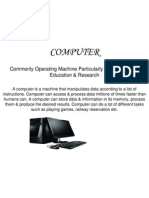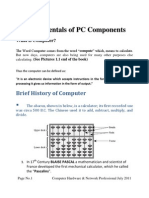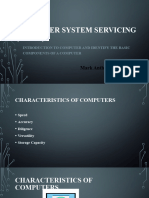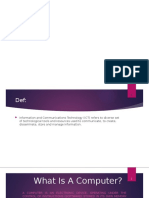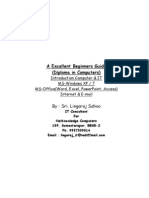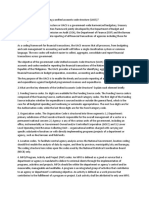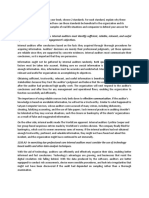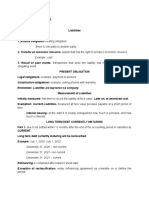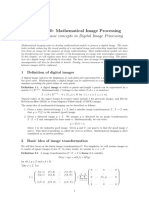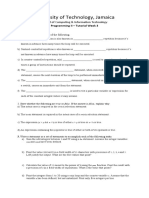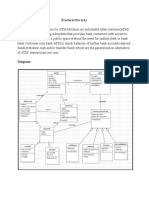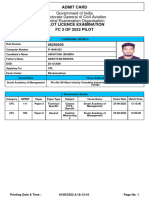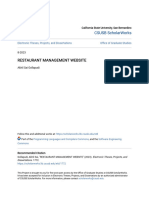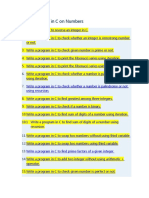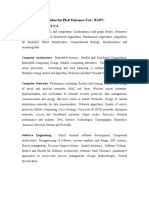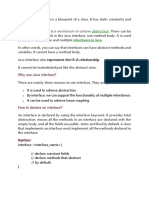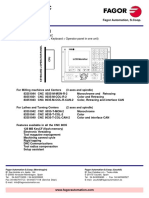Course Name : IT Tools and Business System
Module Names : Computer Appreciation
TABLE OF CONTENT
UNIT NUMBER1/8
� E-Content of
IT TOOLS AND BUSINESS
Syllabus
1.1 Objectives
1.2 What is Computer?
1.2.1 Introduction to Computer
1.3 Characteristics of Computer
1.3.1 Characteristics of Computer
1.4 Components of Computer System
1.4.1 Components of Computer System
1.5 Computers-Number System
1.5.1 Computer-Number System
1.5.1A Binary Number System
1.5.1B Decimal Number
System
1.6 Conversion to and from other number systems
1.6.1 Conversion to and from other number systems
1.7 ASCII Code
1.7.1 ASCII Code
1.8 Unicode
1.8.1 Unicode
1.9 Summary
1.10 Model Questions
Assessment 1
Assessment 2
Reference
Page |
� E-Content of
IT TOOLS AND BUSINESS
Chapter : 1.1 Objectives
Objectives
At the end of the course the user will be able to
Understand, how the computer works?
Know the different characteristics and components.
Understand the computer-number system.
Know the ASCII code and UNICODE.
Page |
� E-Content of
IT TOOLS AND BUSINESS
Chapter: 1.2 What is Computer Topic: 1.2.1 Introduction to Computer
Introduction to Computer
The term "Computer" is derived from the Latin word "Computare" which means
"to compute" or "to calculate."
Computers are machines that perform tasks or calculations according to a set of
instructions or programs.
It is an electronic device used to store data and gives the results accurately
within a fraction of second.
FIG 1.1: Computer
Computers are extensively used everywhere.
It mainly consist of four basic unit such as,
Input Unit
Storage Unit
CPU
Output Unit
Page |
� E-Content of
IT TOOLS AND BUSINESS
Classification of Computer
Analog Computer
Hybrid Computer
Digital Computer
FIG 1.2: Types of Computer
Analog Computer
An analog computer represents the data as physical quantities and operates on
the data by manipulating the quantities.
It is designed to process data in which the variable quantities vary continuously.
FIG 1.3: Analog Computer
Page |
� E-Content of
IT TOOLS AND BUSINESS
Hybrid Computer
A hybrid is a combination of digital and analog computers.
It combines the best features of both types of computers, i.e. It has the speed of
an analog computer and the memory and accuracy of digital computer.
It accepts analog signals, converts them into digital and processes them in digital
form.
A hybrid computer may use or produce analog data or digital data.
It accepts a continuously varying input, which is then converted into a set of
discrete values for digital processing.
FIG 1.4: Hybrid computer
Digital Computer
A digital computer is designed to process the data in numerical form, its
circuits perform mathematical operations of addition, subtraction, multiplication
and division.
The numbers operated on by a digital computer are expressed in the binary
system.
Page |
� E-Content of
IT TOOLS AND BUSINESS
Digital Computers are generally classified by size and power as follows
Micro Computer
Mini Computer
Mainframe Computer
Super Computer
Micro Computer
Micro Computer is a small, relatively inexpensive computer with a
microprocessor as its CPU.
The invention of the microprocessor (single chip CPU) gave birth to the much
cheaper microcomputers.
FIG 1.5: Micro Computer
Micro Computers are commonly divided into four types such as
Desktop
Laptop
Notebook
PDA (Personal Digital Assistant)
Page |
� E-Content of
IT TOOLS AND BUSINESS
Desktop Computer
A desktop computer is a personal computer (PC) in a form intended for
regular use at a single location.
Early desktop computers are designed to lie flat on the desk, while
modern towers stand upright.
Most modern desktop computers have separate screens and keyboards.
FIG 1.6: Desktop Computer
Laptop Computer
A laptop is a portable computer that has same capabilities as a desktop,
but is small enough for easy mobility.
FIG 1.7: Laptop computer
Page |
� E-Content of
IT TOOLS AND BUSINESS
Notebook Computer
A notebook computer has a keyboard with an attached screen.
A notebook's screen is thinner than the usual desktop computer monitor
because the machine is designed to be portable, which is why the
notebook itself is small, compact, and lightweight.
FIG 1.8: Notebook Computer
Personal Digital Assistant (PDA)
Personal Digital Assistant (PDA) is a device similar to a computer that fits
in the palm of users hand and allows them to collect information such as
contacts, appointments, files, programs, and more.
FIG 1.9: PDA
Page |
� E-Content of
IT TOOLS AND BUSINESS
Mini Computer
Mini computers were designed for control, instrumentation, human interaction,
and communication switching as it is distinct from calculation and record
keeping.
FIG 1.10: Mini Computers
A small, multi-user computer that can support 10 to hundred
users simultaneously.
Page |
� E-Content of
IT TOOLS AND BUSINESS
Mainframe Computers
Mainframe Computers is a powerful multi-user computer that can support
thousand users simultaneously.
Mainframe computers can also process data at very high speeds, i.e.,
hundreds of million instructions per second and they are also quite expensive.
Normally, they are used in banking, airlines and railways, etc. for their
applications.
FIG 1.11: Mainframe Computers
Super Computer
Super Computers are best in terms of processing capacity and also the most
expensive one.
An extremely fast computer that can perform hundreds of millions instructions
per second.
FIG 1.12: Super Computer
Page |
� E-Content of
IT TOOLS AND BUSINESS
Chapter: 1.3 Characteristics of Computer Topic: 1.3.1 Characteristics of Computer
Characteristics of Computer
Computers have some important features which have made them so popular.
A Computer can be categorized according to
Speed
Accuracy
Versatility
Reliability
Power of remembering
Diligence
Storage
Speed
Computers work at an incredible speed.
It can carry out instructions at a very high speed.
A powerful computer is capable of performing about 3-4 million simple
instructions per second.
It can perform arithmetic and logical operations within a fraction of second.
Accuracy
Computer provides a high degree of accuracy.
Computers perform all jobs with 100% accuracy.
The degree of accuracy of a computer depends on the instruction and
processor type.
Versatility
Computer is versatile in nature.
Page |
� E-Content of
IT TOOLS AND BUSINESS
It can perform different types of task easily.
At one moment user can use the computer to prepare a letter document and
in the next moment they may play music or print a document.
Power of remembering
A computer can store and recall any information because it has secondary
storage.
All information can be retained as long as desired by the user and that can be
recalled almost simultaneously and accurately even after several years.
Diligence
Computers can perform long and complex calculations with the same speed
and accuracy from the start till the end.
Being a machine, a computer does not suffer from the human traits of
tiredness and lack of concentration.
Storage
Large volume of data and information can be stored in the computer and also
retrieved whenever required.
Computer has two types of storage. They are Primary storage and Secondary
storage.
In Primary Storage, a limited amount of data can be stored temporarily like
RAM, ROM.
Secondary storage can store a large amount of data permanently like floppy
and compact disk.
Page |
� E-Content of
IT TOOLS AND BUSINESS
Chapter: 1.4 Components of Computer System Topic: 1.4.1 Components of Computer System
Components of Computer System
The computer is an electronic device that accepts (reads) data from the user and
processes the data by performing calculations and operations on it, and
generates (writes) the desired output.
A computer consists of four major components such as
Input Devices (Input Unit)
CPU (Processing Unit)
Memory (Storage Unit)
Output Devices (Output Unit)
FIG 1.13: Components of Computer
Input Unit
An input device is a hardware or peripheral device used to send data to a
computer.
An input device allows users to communicate and feed instructions and data to
computers for processing, display, storage and/or transmission.
The important and most commonly used input devices are
Keyboard
Mouse
Other input devices are
Page |
� E-Content of
IT TOOLS AND BUSINESS
Joystick
Scanner
Barcode Reader
CPU (Processing Unit)
The CPU is the heart of the computer, it is the part of a computer which interprets
and executes instruction.
Functional block of CPU
The two components in CPU are
Arithmetic and logic unit (ALU)
Control Unit (CU)
FIG 1.14: Functional block of CPU
Arithmetic and logic unit (ALU)
The ALU performs arithmetic and logical operations.
Arithmetic operations include addition, subtraction, multiplication and division.
Page |
� E-Content of
IT TOOLS AND BUSINESS
Logical operations include comparing numbers, letters and special characters.
The ALU is a fundamental building block of the Central Processing Unit of a
computer.
Control Unit (CU)
A Control Unit (CU) handles all processor control signals.
It directs all input and output flow, fetches code for instructions from micro-
programs and directs other units and models by providing control and timing
signals.
Memory Unit
Computer memory is a device that stores computer's data and programs.
FIG 1.15: Computer Memory (RAM)
It stores program, data results or any kind of information.
Memory stores binary information, i.e. 0's and 1's in internal storage areas in the
computer.
Moreover, the term memory is usually used as shorthand for physical memory,
which refers to the actual chips capable of holding data.
Some computers also use virtual memory, which expands physical memory onto
a hard disk.
Page |
� E-Content of
IT TOOLS AND BUSINESS
Output Unit
Output devices are peripheral equipment that converts a computer's output to a
form that can be seen, heard or used as an input for another device, process or
system.
The important output devices, which are used in computer systems are
Monitors
Printer
Graphic Plotter
Page |
� E-Content of
IT TOOLS AND BUSINESS
Chapter: 1.5 Computer-Number System Topic: 1.5.1 Computer-Number System
Computer - Number System
A computer can understand positional number system where they are only in the
form of digits, alphabet, symbols, video, audio, etc.,
But the computer can understand only 0s and 1s, so it converts all data into 0s
and 1s.
A value of each digit in a number can be determined using
The digit
The position of the digit in the number
The base of the number system (where base is defined as the total number of
digits available in the number system).
Number system used in the computer is classified into
Binary number system
Decimal number system
Octal number system
Hexadecimal number system
FIG 1.16: Classification of Number System
Page |
� E-Content of
IT TOOLS AND BUSINESS
Chapter: 1.5 Computer-Number System Topic: 1.5.1A Binary Number System
Binary number system
The binary number system is a numbering system that represents numeric
values using two unique digits (0 and 1).
FIG 1.17: Binary and Decimal Numbers
It is also called as base (2) number system.
0
Each position in a binary number represents a 0 power of the base (2), that is, 2 .
The last position in a binary number represents x power of the base (2), that is,
x
2 where x represents the last position 1. For e.g. 1101.101 (2)
Page |
� E-Content of
IT TOOLS AND BUSINESS
FIG 1.18: Digits Representation of Binary Number
The leftmost bit is called Most Significant Bit (MSB) and the rightmost bit is called
Least Significant Bit (LSB).
FIG 1.19: MSB and LSB
Example
Page |
� E-Content of
IT TOOLS AND BUSINESS
Chapter: 1.5 Computer-Number System Topic: 1.5.1B Decimal Number System
Decimal Number System
The number system that we use in our day-to-day life is the decimal number
system.
The decimal number system has a base 10 as it uses 10 digits from 0 to 9.
In decimal number system, to the left of the decimal point represent units, tens,
hundreds, thousands and so on.
Each position represents a specific power of the base (10).
FIG 1.20: Representation of Place Values
FIG 1.21: Digits Representation of Decimal Number
Example
Page |
� E-Content of
IT TOOLS AND BUSINESS
The above example shows that, decimal number 5319(10), weight of each digit is
power of 10.
Each digit has position number is from right(0) to left(3).That is first digit on right
is zero, the second digit on the right is 1 and so on up to 3.
Page |
� E-Content of
IT TOOLS AND BUSINESS
Chapter: 1.6 Conversion to and from other number systems Topic: 1.6.1 Conversion to and fro
Binary to Decimal Conversion
n
Multiply each bit by 2 , where n is "weight" of bit.
The weight is position of the bit, which starts from 0 on right, then 1 and goes on.
Add the result.
Example
The decimal equivalent of 100111 (2) is 3910)
Decimal to Binary Conversions
The easiest way to convert decimal to its binary equivalent is to use division
algorithm.
Divide by two, keep track of remainder at each step.
Put remainder bit as 0, if that number gets divided by two.
Put remainder bit as 1, if that number is not divided by two.
Page |
� E-Content of
IT TOOLS AND BUSINESS
Example
The Binary equivalent of 25(10) is 11001(2)
Page |
� E-Content of
IT TOOLS AND BUSINESS
Chapter: 1.7 ASCII Code Topic: 1.7.1 ASCII Code
Introduction to ASCII Code
ASCII stands for "American Standard Code for Information Interchange".
ASCII character encoding provides a standard way to represent characters using
numeric codes.
These include upper and lower-case alphabetic characters, numbers, and
punctuation symbols.
ASCII was actually designed for use with teletypes and so the descriptions are
somewhat obscure.
ASCII codes are broadly classified into three groups
Non printable ASCII codes
Printable ASCII codes
Extended ASCII codes
Non printable ASCII codes
33 non printable special characters. The first 32 characters (decimal value
from 0 to 31) which represent letters, digits, punctuation marks and a few
miscellaneous symbols.
Page |
� E-Content of
IT TOOLS AND BUSINESS
FIG 1.22: Non-Printable ASCII characters (Codes)
Printable ASCII codes
94 standard printable characters (decimal value range from 33 to 126) which
represent letters, digits, punctuation marks and a few miscellaneous symbols.
The following table originates from the older, American systems, which
worked on 7-bit character tables.
Page |
� E-Content of
IT TOOLS AND BUSINESS
FIG 1.23: Standard or Lower ASCII characters and codes
Extended ASCII codes
Extended ASCII uses eight instead of seven bits, which adds 128 additional
characters.
This gives extended ASCII the ability for extra characters, such as special
symbols, foreign language letters and drawing characters.
Some important things to note about ASCII codes
Page |
� E-Content of
IT TOOLS AND BUSINESS
The numeric digits, 0-9, are encoded in sequence starting at 30h (HEX).
The upper case alphabetic characters are sequential beginning at 41h.
The lower case alphabetic characters are sequential beginning at 61h.
The first 32 characters (codes 0-1Fh) and 7Fh are control characters.
Most keyboards generate the control characters by holding down a control
key (CTRL) and simultaneously pressing an alphabetic character key.
FIG 1.24: Extended or Higher ASCII characters and codes
Page |
� E-Content of
IT TOOLS AND BUSINESS
Chapter: 1.8 Unicode
Topic: 1.8.1 Unicode
Unicode
Unicode is a universal character encoding standard.
It defines the way individual characters are represented in text files, web pages
and other types of documents.
ASCII, which was designed to represent only basic English characters, but
Unicode was designed to support characters from all languages around the world.
The standard ASCII character set supports only supports 128 characters, while
Unicode can support roughly 1,000,000 characters.
While ASCII uses only one byte to represent each character, Unicode supports
up to 4 bytes for each character.
The Unicode chart contains U+0000 to U+FFFF Unicode characters.
The table shows the range of U+0000 to U+0BFF Unicode characters, decimal
values from 0 to 3071 and the name of Unicode characters from Basic Latin to
Tamil.
Page |
� E-Content of
IT TOOLS AND BUSINESS
FIG 1.25: Unicode Characters
Page |
� E-Content of
IT TOOLS AND BUSINESS
Chapter : 1.9 Summary
Topic : Summary
In this class, user have learnt about
basics of computer
characteristics of computer
components of computer system
concept of computer number system
ASCII code
Unicode
Page |
� E-Content of
IT TOOLS AND BUSINESS
Chapter : 1.10 Model Questions
Topic : Model Questions
Describe basic units of computer.
Explain different types of computer.
Write about the advantages of computer.
Describe Memory Unit.
What is the concept of Computer-Number system? Explain it.
What are the three different sections in ASCII code?
Describe Unicode characters with chart.
Page |
� E-Content of
IT TOOLS AND BUSINESS
Assessment 1
A is a combination of digital and analog computers.
Microcomputer
Hybrid computer
Mainframe computer
Mini computer
Which of the following are components of Central Processing Unit (CPU)”
Arithmetic logic unit, Mouse
Arithmetic logic unit, Control unit
Arithmetic logic unit, Integrated Circuits
Control Unit, Monitor
Which number system is also called as base (2) number system?
Decimal
Octal
Hexadecimal
Binary
In which of the following form, data is stored in a computer ?
Decimal
Binary
Hexadecimal
Octal
Page |
� E-Content of
IT TOOLS AND BUSINESS
The standard ASCII character set supports only supports characters.
128
124
156
172
Answers:
1.b
2.b
3.d
4.b
5.a
Page |
� E-Content of
IT TOOLS AND BUSINESS
Assessment 2
Unicode was designed to support characters from all languages around the world.
True
False
ASCII stands for "American Standard Code for Information Interpretors".
True
False
The decimal number system has a base 10 as it uses 10 digits from 0 to 9.
True
False
Answers:
1.a
2.b
3.a
Page |
� E-Content of
IT TOOLS AND BUSINESS
Books Referred
Introduction To Computer and Communication by D.Ravichandra.
Computer Fundamentals: Architecture and Organization by B.Ram
Fundamental of Computer Organization and Architecture by Jyotsna
Sengupta.
Fundamental of Computing by Anita Goel.
























